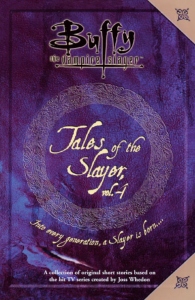The fourth and final “Tales of the Slayer” collection (November 2004) is also the only one centered around a theme: specifically, the Cruciamentum – as seen in “Helpless” (3.12) — wherein the Slayer is weakened by drugs and forced to defeat a vampire via only her wits and fighting skills. Remarkably, these aren’t just eight tales of Slayers being betrayed by their Watchers and feeling horrible; the authors find a variety of angles with which to approach the concept. Here are my rankings, from best to weakest, although there isn’t a bad story in the bunch:
1. “Survivors” (1919, Chicago) by Kristine Kathryn Rusch – Rusch, an author I once criticized for the bad “Star Wars” novel “The New Rebellion,” pens the most evocative tale of this collection as Dot the Vampire Slayer patrols the sweltering and odoriferous slaughterhouse district of the Windy City. Adding extra intrigue, the populace is in a foul mood with Prohibition becoming the law of the land the next day. The highlight, though, is the unusual Slayer-Watcher relationship. Reginald is shell-shocked from the war and gradually losing his mind, so Dot does everything she can to cover for him in the eyes of the Watchers’ Council, as he is the only family she has.
2. “The Rule of Silence” (1481, Seville, Spain) by Kara Dalkey – Esperanza the Vampire Slayer unquestionably faces the most horrifying spin on the Cruciamentum in this book as she is captured by the Spanish Inquisition. A good history lesson, Dalkey’s story illustrates how the Inquisitors seek to purge Spain of non-Christians by inventing various crimes and sentencing people to death. The best a target can hope for is that their land is stolen by the church and they are kicked out of the country. Esperanza goes through psychological and physical torture in the Inquisition’s castle while holding on to hope that the Watchers’ Council will bail her out. The answer to her hopes tidily wraps up one of the grimmest tales from any of the volumes.
3. “Undeadsville” (1952, New York City) by Michael Reaves – Reaves, a notable “Star Wars” Legends” author, gets creative here by alternating between the points of view of Slayer Zoe, Watcher Sykes and vampire Faust, who was once a Watcher. Faust is the first Watcher-vampire I can think of in Buffyverse lore, and the first of two in this book. Reaves entertainingly writes Zoe’s POV in the style of beat poets, so while the yarn definitely takes a dark turn, it remains a fun, rhythmic read.
4. “Two Teenage Girls at the Mall” by Jane Espenson (1983, Keller, Nebraska) – This isn’t the first Buffyverse story from the POV of a newly risen vampire, but it’s one of the more robust and entertaining. Plus, “Buffy” TV veteran Espenson throws in some teenage-girl friendship politics between Julie the vampire and Peri the Vampire Slayer. And we also get a slice of mall nostalgia, although this story takes place in an empty one overnight – which I suppose evokes the modern state of malls rather than the thriving era.

5. “Sideshow Slayer” (1911, Pennsylvania) by Greg Cox – Cox gives a creative answer to the question of where olden-day Slayers could hide in plain sight: in a circus freak show, of course. Millie the Vampire Slayer comes up with one of the most creative strategies for dispatching a vampire: She leads him into the hall of mirrors. Thus the vampire sees multiple versions of Millie, whereas she sees only one vampire.
6. “It’s All About the Mission” (1973, Harlem) by Nancy Holder – This is a cute story showing how Nikki Wood fashions herself as a real-life version of blaxploitation heroine Cleopatra Jones, although its view of the Cruciamentum is the same as in “Helpless.” Watcher Bernard Crowley muses: “(It) was the most idiotic ritual he could imagine.” It’s refreshing that Crowley and his nephew, Jonah, stay on Nikki’s side after she gets pregnant by an off-page guy who is never mentioned, and it’s cute that the younger Jonah has a crush on Nikki. She doesn’t have the baby, Robin, here, but there are two more Nikki novels in the pipeline: “Spark and Burn” and “Blackout.”
7. “Alone” (1876, Ulster, England) by Scott Allie – Allie, who oversaw most of Dark Horse Comics’ Buffyverse run, delivers a solid story with the familiar premise wherein a Slayer has to hide her calling from the public. In this case, Catherine pretends to be the wife of her relatively young Watcher, Mr. Callan. Most of the tale involves the awkwardness of Catherine’s parents meeting the stiff and all-business Mr. Callan, allowing us some amusement at their attempts to maintain decorum. The villain of the piece is a surprising twist.
8. “Back to the Garden” (1969, Nova Scotia) by Robert Joseph Levy – Levy, who would go on to write the excellent Faith book “Go Ask Malice: A Slayer’s Diary,” here invents Beryl the Vampire Slayer, who runs away to a commune during a time when many Americans are escaping the draft by fleeing to Canada. The author does a decent job of portraying the time and place, although the use of the Cruciamentum as the climactic test is rather expected in this collection.
Click here for an index of all of John’s “Buffy” and “Angel” reviews.

